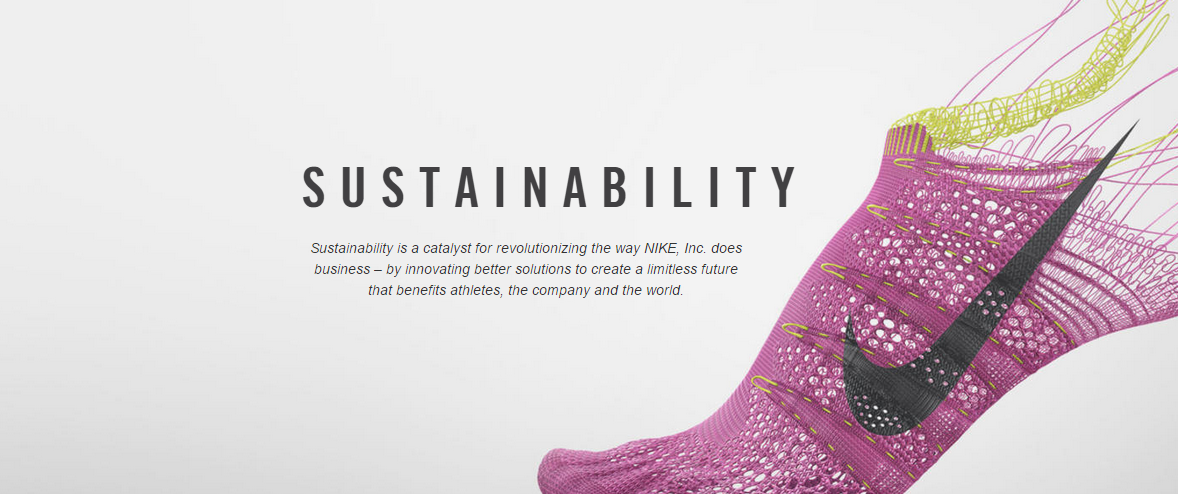Large public companies can take a leading role in building a sustainable economy, while also supporting their stakeholders’ interests, by changing operational and production processes, harnessing their supply chain, and leveraging R&D in new product development. Yet not all companies choose this strategy. In fact, our research shows a wide opportunity gap between leaders and laggards even within the same industry. For example, in the athletic footwear and apparel industry Nike stands out as a leader in sustainable business practices, while Under Armour seems to have chosen a very different path.
Few global brands communicate corporate identity as well as Nike. Its swoosh stands for athleticism, and authenticity. The imperative of “Just Do It”, coupled with performance athletic design, and smart, savvy ad campaigns has made Nike an inspirational brand for consumers and competitors alike.
One of the less appreciated aspects of Nike’s culture is its commitment to environmental sustainability, or what Terra Alpha would call, its Environmental Productivity. Nike exceeds Terra Alpha’s disclosure requirements for environmental data and information. The company reports CO2 emissions, waste and water data, and sets ambitious goals for emissions and resource use reduction. Its Impact Report displays a high level of visibility into its supply chain; having learned hard lessons from being a poster child for exploitative labor practices in the 1990s.
Nike CEO Mark Parker writes, “For NIKE, sustainability has never been a test case. Over the decades, it’s shaped some of our most popular products and fastest-growing platforms. Now, I believe we’re entering a new phase for NIKE innovation – one where sustainability at scale is becoming a reality.” To give a sense of scale, if Nike Air were a standalone athletic company, based on revenue, it would be the third-largest in the world. Nike Air soles, used in 50% of Nike’s footwear, now use at least 50% recycled manufacturing waste. Since 2008, this effort has diverted more than 50 million pounds of waste from landfills each year. Polyester is another focus for Nike, as it comprises 32% of its overall carbon footprint. Since 2010, Nike has transformed more than 6.4 billion plastic bottles into recycled polyester footwear and apparel, and it has used the most recycled polyester in the industry for six years in a row. For its water target, Nike aims to see a 20% reduction in freshwater use in textile dyeing and finishing per unit of production from 2016 to 2020. Nike takes a “whole facility” approach, meaning it includes the entirety of facilities that might have non-Nike related water intensive manufacturing on site. Another key focus is on wastewater treatment, which Nike reports on in detail, describing standards setting and compliance rates across its supply chain. The company’s target is 100% compliance by 2020. Currently 58% of the cotton used in Nike product is organic, with a goal of taking that to 100% by 2020.
One can clearly see the scale benefits to innovation, and we are reminded of how influential this type of thinking can be when compliance with best practices is mandated across a vast supply chain. On the energy and carbon front, Nike is part of RE100, a business coalition that incentivizes incremental investment in renewable energy. Nike will meet its 100% renewable energy pledge at its owned facilities largely through investment in de novo wind and solar capacity, rather than through the purchase of renewable energy credits. Extending to its supply chain, rooftop solar now supplies 20% of electricity demand for Nike’s largely Asiabased contract manufacturers. On the waste front, by the fourth quarter of FY18, 99.9% of Nike’s footwear finished goods manufacturing waste was recycled or converted to energy, and the company is impressively closing the loop to meeting its 100% zero manufacturing waste to landfills target.
That is not by any means a complete picture of all that Nike is doing, but it highlights Nike’s intentionality when it comes to the environment. By contrast, its smaller competitor, Under Armour, does not report even the basic environmental metrics that Terra Alpha requires for consideration, nor does the company explain its approach to managing natural resources. In our opinion, it is inevitable that virgin raw material prices will increasingly rise to reflect structural supply/demand imbalances (especially in key product inputs in textiles and footwear like water and virgin plastics). As this happens, it will pressure company margins and divert management attention. The failure of Under Armour to provide stakeholders (investors, customers, and employees) with a thorough report of the company’s sustainability efforts undermines the value of the company and, we believe, is an indication of lower quality management of the business. This may, in part, explain the very different investor returns experience with NKE vs UA.

It is our contention that companies that recognize and are working to effectively manage the natural resource challenges facing our economy are likely to be better prepared for future success in their markets. We also believe that large companies can, if they choose, be a force for positive change in our economy, the environment, and across our society.

